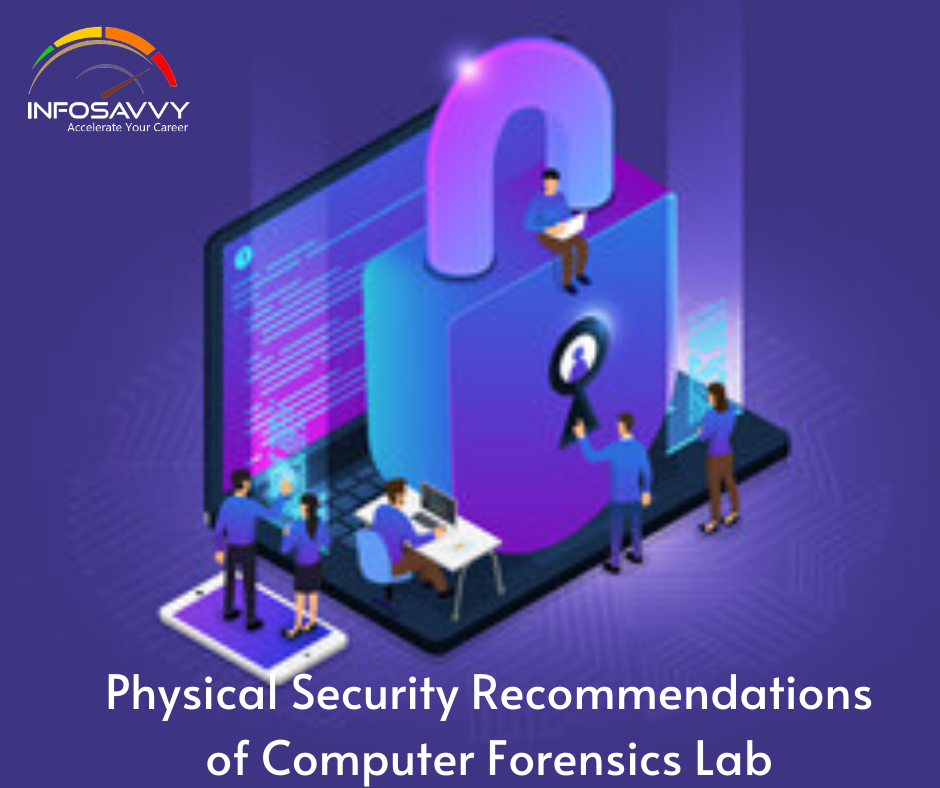Physical Security Recommendations in the level of physical security required for a forensics lab depends on the nature of investigations performed in the lab. The assessment of risk for a forensics lab varies from organization to organization. If the organization is a regional forensics lab, then the assessed risk is high as the tabs deal with multiple cases and different types of evidence. This may not be true for the forensics lab of a private firm.
Maintain a log register at the entrance of the lab to record the following data name of visitor with date, time, purpose of the visit, name of contact person, and address of the visitor. Provide visitors with passes to distinguish them from the lab staff, Place an alarm in the lab to provide an additional layer of protection and deploy guards around the premises of the lab. Place dosed-circuit cameras in the lab and around its premises to monitor human movement within the lab. Ensure security of the lab by keeping all the windows closed. This helps prevent unauthorized physical access to the lab from a covert channel.
Place fire extinguishers within and outside the lab, and provide training to the lab personnel and guards on how to use the fire extinguisher, so that personnel know how to use the equipment effectively in case of fire.
Shield workstations from transmitting electromagnetic signals, as electronic equipment emit electromagnetic radiation, which can be helpful to discover the data the equipment is transmitting or displaying. The solution is to shield emissions through a process the U.S. Department of Defense has named TEMPEST.
Related Product : Computer Hacking Forensic Investigator
It is stated by The National Industrial Security Program Operating Manual (NISPOM) that, “TEMPEST is an unclassified short name referring to investigations and studies of compromising emanations. Compromising emanations are unintentional intelligence-bearing signals that if intercepted and analyzed will disclose classified information when it is transmitted, received, handled, or otherwise processed by any information processing equipment.”
Computer Hacking Forensic Investigator | CHFI v9 aims at elevating the knowledge, understanding, and skill levels of in cyber security and forensics practitioners. Get trained from Infosavvy with the help of their experienced Trainer and groom up your skills.
To prevent eavesdropping, TEMPEST labs use sheets of metal, good conductors such as copper for lining the walls, ceilings, and floor. Insulate the power cables to prevent radiation and add filters to the telephones within the lab.
It is costly to build a TEMPEST lab, as it goes through checks and maintenance at regular intervals. As a replacement for a TEMPEST lab, some vendors have come up with low-radiation workstations. The cost of such kinds of workstations is more than the normal forensics workstation.
Fire – Suppression Systems
Fire can be disastrous in the forensic lab. Any electrical device can be a source of fire, though it does not generally happen in the computer. On a few occasions, short circuits can also damage the cable. It might even ignite a flammable item close by.
There may be fire in the computers as well if the servo-voice-coil actuators freeze because of damage in the drive. The frozen actuators interrupt the movement of the head assembly and the internal programming of the disk’s circuit forces the movement by applying more power to the servo-voice-coil actuators. The components of the drive can handle a certain amount of power before they fail and overload the ribbon connecting the drive to the computer. The ribbons do not respond to excessive power. High voltage passing through the ribbon causes sparks.
Also Read : Physical Location and Structural Design Considerations
For fire suppression systems:
- Install a dry chemical fire extinguisher system to deal with the fire accidents that occur because of chemical reactions.
- Check the installation of fire sprinklers and make sure they are working.
- The fire extinguishers must be accessible when needed.
A wet sprinkler system has an overhead sprinkler piping generally concealed above the ceiling. This system consists of pipes filled with pressurized water and connected to the sprinkler heads, which infiltrate through the ceiling. Every sprinkler head makes use of the fusible links, which melt in extreme heat allowing the water to flow. This system fulfills the basic requirements and is cost effective. In case of fire, it will trigger the sprinklers only in the affected areas.
The interlocked dry pipe systems use water as the extinguishing agent. This system activates when:
- The temperature rise melts the fusible link on the sprinkler head.
- The electronic detection of fire or smoke opens the sprinkler head valve, allowing water flow into the system.
This system minimizes the risk of inadvertent discharge of water, but has a reasonable first cost premium compared to a wet pipe system.
CO2 and FM200 are chemical or gaseous system types that use an electronic fire or smoke detection technique to release the extinguishing agent. They are more advantageous and respond rapidly to mitigate a developing fire. These systems require limited cleaning.
Fires in labs produce harmful chemicals, which obstruct the emergency response team. Therefore, install exhaust systems to remove these toxic products.
The dry chemical type fire extinguisher is currently more popular. It extinguishes Class A, B, or C fires. Class A refers to paper, trash, and plastic; Class B refers to flammable liquids and gases; and Class C refers to energized electrical equipment.
Questions related to this topic
- What is a good practice for physical security?
- What are some examples of physical security measures?
- What are the 5 physical security controls required for information security?
- What are the 3 parts to physical security standards?
This Blog Article is posted by
Infosavvy, 2nd Floor, Sai Niketan, Chandavalkar Road Opp. Gora Gandhi Hotel, Above Jumbo King, beside Speakwell Institute, Borivali West, Mumbai, Maharashtra 400092
Contact us – www.info-savvy.com



